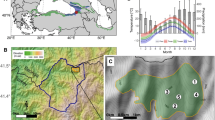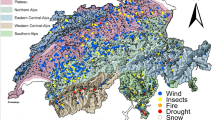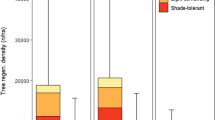Abstract
The effects of a typhoon on forest dynamics and the response of major tree species were studied in a warm-temperate evergreen broad-leaved forest in southwestern Japan. The strongest typhoon on record (T9313) passed through this region in 1993. Return periods of typhoons over 30 ms−1 in instantaneous wind velocity and T9313 were estimated to be 2.2 and 104.5 years, respectively. Approximately 10% of all stems suffered some damage from T9313 and annual stem mortality rose from 1.3 to 2.7%. The estimated period that the number of stems would fall below 10% of the initial was four years shorter with T9313-class typhoons than without them. Thus, the disturbance by T9313 was not catastrophic at the site although T9313 was an episodic typhoon. The short-term responses of major tree species to T9313 were classified into four types: 1) blunt-response type with little decrease and recruitment of stems in the DBH ≥ 5 cm class (Distylium racemosum), 2) retreat type with larger decrease than recruitment (e.g. Quercus acuta), 3) sharp-response type with a large decrease and much recruitment (e.g. Cinnamomum japonicum), and 4) advance type with less decrease than recruitment (Eurya japonica). Among the four regeneration types classified by previous studies (climax, light-demanding, subcanopy, and few-sapling), the climax and few-sapling types each showed a specific short-term response, the blunt-response and retreat types, respectively, that explains one aspect of the regeneration strategies of each type. On the other hand, the light-demanding or sub-canopy type showed multiple short-term responses, indicating that each regeneration type contains species with various regeneration strategies.
Similar content being viewed by others
Literature cited
Basnet, K., Likens, G.E., Scatena, F.N., and Lugo, A.E. (1992) Hurricane Hugo: Damage to a tropical rain forest in Puerto Rico. J. Trop. Ecol. 8: 47–55.
Bellingham, P.J. (1991) Landforms influence patterns of hurricane damage: Evidence from Jamaican Montane forests. Biotropica 23: 427–433
Bellingham, P.J., Kohyama, T., and Aiba, S. (1996) The effects of a typhoon on Japanese warm temperate rainforests. Ecol. Res. 11: 229–247.
Everham, E.M., III, and Brokaw, N.V.L. (1996) Forest damage and recovery from catastrophic wind. Bot. Rev. 62: 113–185.
Foster, D.R. (1988) Species and stand response to catastrophic wind in central New England, USA. J. Ecol. 76: 135–151.
Frangi, J.L. and Lugo, A.E. (1991) Hurricane damage to a flood plain forest in the Luquillo Mountains of Puerto Rico. Biotropica 23: 324–335.
Fukuoka District Meteorological Observatory (1996) Long-term meteorological data in Kyushu and Yamaguchi district; commentary materials No. 19. 525pp, Fukuoka Meteorological Station, Fukuoka. (in Japanese)
Glitzenstein, J.S. and Harcombe, P.A. (1988) Effects of the December 1983 Tornado on forest vegetation of the Big Thicket, Southeast Texas, USA. For. Ecol. Manage. 25: 269–290.
Gresham, C.A., Williams, T.M., and Lipscomb, D.J. (1991) Hurricane Hugo wind damage to southeastern U.S. coastal forest tree species. Biotropica 23: 420–426.
Hall, P., Ashton, P.S., Condit, R., Manokaran, N., and Hubbell, S.P. (1998) Signal and noise in sampling tropical forest structure and dynamics.In Forest biodiversity research, monitoring and modeling: conceptual background and old world case studies. Dallmeier, F. and Comiskey, J.A. (eds.), 671 pp, UNESCO, Paris, 63–77.
Iwai, S. and Ishiguro, M. (1970) Applied hydrological statistics. 370pp, Morikita Pub., Tokyo. (in Japanese)
Kira, T. (1991) Forest ecosystems of East and South-East Asia in a global perspective. Ecol. Res. 6: 185–200.
Lugo, A.E., Applefield, M., Pool, D.J., and McDonald, R.B. (1983) The impact of Hurricane David on the forests of Dominica. Can. J. For. Res. 13: 201–211.
Meteorological Business Support Center (1998) CD-ROM; The Encyclopedia of typhoons. Maruzen Co., Ltd., Tokyo. (in Japanese)
Miyazaki Local Meteorological Observatory (1993) Monthly report of meteorology in September in Miyazaki Prefecture. 29 pp, Japan Weather Association Miyazaki Branch, Miyazaki. (in Japanese)
Naka, K. (1982) Community dynamics of evergreen broadleaf forests in southwestern Japan. I. Wind damaged trees and canopy gaps in an evergreen oak forest. Bot. Mag. Tokyo 95: 385–399.
Nakashizuka, T. and Yamamoto, S. (1987) Natural disturbance and stability of forest community. Jpn. J. Ecol. 37: 19–30. (in Japanese with English summary)
Pickett, S.T. A. and White, P.S. (1985) The ecology of natural disturbance and patch dynamics. 472pp, Academic Press Inc., San Diego.
Sato, T., Kominami, Y., Saito, S., Niiyama, K., Manabe, T., Tanouchi, H., Noma, N., and Yamamoto, S. (1999) An introduction to the Aya Research Site, a long-term ecological research site, in a warm temperate evergreen broad-leaved forest ecosystem in southwestern Japan: Research topics and design. Bull. Kitakyushu Mus. Nat. His. 18: 157–180.
Takyu, M. (1998) Shoot growth and tree architecture of saplings of the major canopy dominants in a warm-temperate rainforest. Ecol. Res. 13: 55–64.
Takyu, M. and Ohsawa, M. (1997) Distribution and regeneration strategies of major canopy dominants in species-rich subtropical/warm temperate rainforests in south-western Japan. Ecol. Res. 12: 139–151.
Tanouchi, H. and Yamamoto, S. (1995) Structure and regeneration of canopy species in an old-growth evergreen broad-leaved forest in Aya district, southwestern Japan. Vegetatio 117: 51–60.
Webb, S.L. (1989) Contrasting windstorm consequences in two forests, Itasca State Park, Minnesota. Ecology 70: 1167–1180.
Yamamoto, H., Suzuki, Y., and Hayakawa, S. (1994) Agricultural damages in Kyushu and Yamaguchi district by Typhoon 9313. J. Agric. Meteorol. 49: 285–290. (in Japanese)
Yamamoto, S. (1992a) Gap characteristics and gap regeneration in primary evergreen broad-leaved forests of western Japan. Bot. Mag. Tokyo 105: 29–45.
Yamamoto, S. (1992b) The gap theory in forest dynamics. Bot. Mag. Tokyo 105: 375–383.
Yamamoto, S. (2000) Forest gap dynamics and tree regeneration. J. For. Res. 5: 223–229.
Author information
Authors and Affiliations
Additional information
In this paper, I analyzed data from the database that was compiled by the Aya Research Team.
About this article
Cite this article
Saito, S. Effects of a severe typhoon on forest dynamics in a warm-temperate evergreen broad-leaved forest in southwestern Japan. J For Res 7, 137–143 (2002). https://doi.org/10.1007/BF02762602
Received:
Accepted:
Issue Date:
DOI: https://doi.org/10.1007/BF02762602




